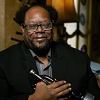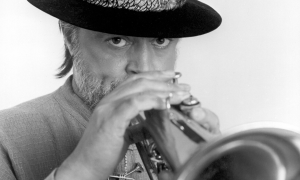Home » Jazz Articles » Catching Up With » Cecil Young: On Coming Home
Cecil Young: On Coming Home

I see every musician as being on a spiritual journey through an instrument.
—Cecil Young
What is most interesting about Young's engagement in Seattle is the question of how he will deal with the Fellowship's ideal that those who perform there are able to call their music, "jazz." Certainly Young's professional recorded output would raise major flags as to whether this was possible. No matter how broad a description one attaches to this question, Young's primary work with the multimedia super-band, M'lumbo, offers a deep and complex query into the overall artistry of its participants, with ties to jazz that are more elemental than stylistic. It is not, however, jazz music per any notion of definition. Adding intrigue and mystery to the equation is that Young has attached a title to the performance that, like his music, is open to interpretation as far as its meaning is concerned. Titled "Experience the Joker's Wild," the words carry a meaning that can shift simply by altering its punctuation. More on this to come, as a full understanding of how Young fits into this equation requires a brief foray into his family history in Seattle, and the impact it had on his creative self.
Long before Young attended Seattle's Garfield High School, he was enamored with the drumming of Clarence Acox, the longtime director of the school's vaunted, award-winning jazz band. His father, keyboardist and multi-instrumentalist Gaylord Young, played in a prominent Seattle band dubbed Elbowed Out, with Acox on drums. The future trumpeter was fascinated with the full sound and amazing technique displayed by his future mentor. Elbowed Out had a sound that most resembled the music of The Crusaders and Herbie Hancock's early 1970s bands. The combo would back prominent artists as they passed through town, a common practice in those times due to Seattle being viewed as a bit of a remote outpost. The elder Young and his mates would back artists such as James Brown, The O'Jays and Tower of Power, before touring on their own behind several recordings.
Gaylord Young was a man of principle, both on and off the bandstand. He was President of the Garfield High School chapter of the Black Panthers, and a multi-instrumentalist that made things happen in his community. His social engagement was cross-cultural, something etched into Seattle history on the corner of 19th and Yesler, in the form of a totem he was invited to help create with local tribal leaders. Speaking about his dad, Young cites Thomas Marriott's work with the Seattle Jazz Fellowship as mirroring his way of approaching things. "Like Tom, he was willing to do something and be about something." When his son Cecil arrived at Garfield, teachers knew he was Gaylord's son without any question or doubt. His dad's personage had carried that much weight even as a young student.
Young's fascination with the drums was short-lived, eventually choosing the trumpet as he headed into middle school. Acox, long before Young's entrance into Garfield under his tutelage, would nonetheless be a major influence. "I knew Clarence growing up, he was in a band with my father called Elbowed Out. I started to get into music because of my dad, but also because of Clarence," he recalls.
Young's arrival at Garfield in Seattle's traditionally Black Central District neighborhood, coincided with the arrival of a number of young musicians who would rise to jazz prominence. Trombonist David Marriott, Jr., and his younger brother, trumpeter Thomas Marriott, and bassist Michael Glynn are all currently heavy hitters on the Seattle scene. Perhaps the most influential and inspiring to Young was senior trumpeter Lamont McGraw. His sound, and the Garfield band's heavy focus on the blues and the swing rhythm, set Young on a path common to jazz trumpeters to this day—one blazed by the great Miles Davis. McGraw's ability to play in high registers and achieve an enviable sound overall, revealed to him what could be done with his instrument of choice. "It was such a special time in that school, with those kids. I met so many talented young people," he reminisces.
Time under Acox at Garfield proved to be a foundational experience for Young. It provided him the tools to seek out the knowledge of his elders on the Seattle scene, and begin to form bands and perform locally. He credits pianist/vocalist Darrius Willrich with broadening his knowledge of harmony theory, giving him a deeper understanding of his fascination with Davis. He realized there was something deeper than the blues to explore, a notion that turned the key and unlocked the musical and spiritual possibilities before him.
Trying his hand as a bandleader and sideman in Seattle in the early 1990's, Young applied many of Acox's concepts for big band, to the small band setting. Traditionally, big bands rehearse in smaller groups leading to full rehearsals. Young's time exercising these principles enabled him to have a more intimate time with some of the city's jazz elders, receiving an education not available in institutions of higher learning. "It's something I carry with me, that big band way of doing things," says Young.
While the big band era may have vaporized mostly due to economics, jazz musicians, especially Black jazz musicians, still were somewhat marginalized after the merger of Seattle's two racially segregated unions. AFM 76 and AFM 493 formally merged in January of 1958. With gigs requiring a union card, white club owners figured out ways to stay the course in hiring mostly white players. Smaller ensembles were the result. While the bebop revolution had in itself become a small group phenomena, it is hard to predict what might have become of big bands in that idiom, if the arbitrary suspension of union cards and cabaret cards wasn't so commonly applied to Black jazz musicians in cities across the country. With his involvement in quartet and quintet settings, Young learned he could apply the sectional rehearsal tradition by getting together with the other horn player, or the pianist in the band first, before the full gathering took place.
Young was fortunate in spending time performing with Seattle jazz veterans, Hadley Caliman, Phil Sparks, Larry Jones and Larry Fuller. "They were key in my development and allowed me to do my ego and hire them as my band members. Phil would let us practice at his house. Hadley and I would practice together first. We called the band, The Monsters on the Loose, he recalls with a broad smile. Sparks was announced as a member of Young's band performing at the Seattle Jazz Fellowship, now some thirty years since those humble beginnings of Young's musical journey.
Like many young jazz musicians, and the Seattle jazz community in general, Young attended the Wednesday-night sessions at the New Orleans Creole Restaurant in Pioneer square that included among others, Acox and Sparks. Seattle trumpet legend Floyd Standifer was there for Young and other trumpet enthusiasts to absorb. On a special occasion, Young attended a program presented by iconic bassist Reggie Workman and influential New York trumpeter, Jimmy Owens. His short time with these two masters provided the impetus to make a decision to relocate to New York to pursue his art. Before long, he was studying at the New School, and exploring the scene in Gotham.
"When I got there, I wanted to be around the same type of people that influenced Miles. Heavy people that you can discuss anything with—beyond the collegiate concerns of schools," he recalls. Young's impression of New York compared socially to his native Seattle was in the end, dead on. His personality was more of the hard edged, directly communicative attitude of his new city. He saw Seattle people as being "soft." He saw how it affected Seattle musicians and people he was very fond of.
While a student at the New School, Young realized he needed to hustle and pay dues on the New York scene, and began to browse through help-wanted ads seeking work as a trumpet player. Inevitably, this led to his now twenty-five year association with the multimedia musical phenomena that is M'lumbo. M'lumbo has a multi-genre identity musically, presented in concert with multimedia interactions. The band's founder, Rob Flatow, was impressed with Young's interview, and in hiring him, added a jazz element that replaced the band's previous trumpeter that was more pop oriented. Young's friend and fellow New School student, Jaz Sawyer, was hired by Flatow as well to play drums.
Born at the original Knitting Factory in New York, M'lumbo was an escape from commercial music, and for Young, an environment ripe for experimentation. 'We had an open heart about experimentation. I consider myself a particular kind of scientist. My lab is a rehearsal studio. I'm always trying things, not caring about how terrible it sounds at the beginning," says Young. All in all, being involved with Flatow and his vision, and being in New York in general, placed the young trumpeter squarely in the middle of the type of people he was seeking when departing Seattle for New York. At the beginning, this included his fellow students and teachers at The New School. Over the years, it was just New York, that semi-transient, constantly flowing funnel of energy and inspiration bordered with hard, hard edges. It requires a warrior spirit at times, which fell in line with Young's vision of the musician's artistic journey. "I also see musicians in the same way that I see Samurai people, or monks. We are actually committed to a particular way of thinking about something. The intricacies that dictate and control your life parameters and what your bubble really is about. I see every musician as being on a spiritual journey through an instrument," he states.
In recent times, the band has collaborated with saxophonist Jane Ira Bloom, one of Young's mentors at the New School. He fondly remembers Bloom uncovering the virtues of persistence as an artist. "She would make you learn a song by heart, no matter how long it took you."
Young's return to Seattle to perform is a celebration of his artistry and an embrace from his native digs in Seattle. His decision to title the show, "Experience the Joker's Wild" presents intrigue and forethought in advance of the performance. Without revealing too much in terms of the answers, Young can best explain the premise by asking questions of his audience. He asks, "What is a joker? The psychology of it, what am I trying to say?" "The joker is entailing a lot of what is going on right now, in a lot of psychological and emotional ways. What's real, what's not. Who is gaslighting you, who is telling you the truth. What are these people's true intentions behind what they are telling you? Is the joker inherently wild, do we need to get rid of him or repair what is wrong. The joker is the ultimate passport," he adds. Of course, further revelations and others entirely will require attendance at his Seattle performance. The band Young has formed includes friends from Seattle that he has known the entirety of his musical life, as well as two of the most notable new faces on the Seattle scene. Bassist Phil Sparks has been a foundational presence for Young, and trombonist David Marriott, Jr. graduated with Young at Garfield High School. Both represent his primal beginnings in jazz. Pianist/keyboardist Ryan Burns is a master of electronic keyboards, including vintage synths. His piano work is highly regarded as well. Drummer/composer Xavier Lecouturier has an album of original tunes released on Origin Records, and is a member of the band Meridian Odyssey, another group of Origin artists. Tenor saxophonist Jackson Cotugno employs a modern approach, delivered with an "old sound." The two represent the vibrant energy of those starting out on the journey Young began, now more than thirty years ago. Given access to a stage in his hometown, Young will tell his story with his horn, and with his spirit that has evolved over twenty-five years in New York pursuing the day to day of making a living with his art in challenging times.
Tags
Catching Up With
Cecil Young
Paul Rauch
United States
Washington
Seattle
Thomas Marriott
Clarence Acox
The Crusaders
Michael Glynn
Miles Davis
Darrius Willrich
Hadley Caliman
Phil Sparks
Larry Jones
Larry Fuller
Floyd Standifer
Reggie Workman
Jimmy Owens
Rob Flatow
Jaz Sawyer
Knitting Factory
Jane Ira Bloom
PREVIOUS / NEXT
Support All About Jazz
 All About Jazz has been a pillar of jazz since 1995, championing it as an art form and, more importantly, supporting the musicians who make it. Our enduring commitment has made "AAJ" one of the most culturally important websites of its kind, read by hundreds of thousands of fans, musicians and industry figures every month.
All About Jazz has been a pillar of jazz since 1995, championing it as an art form and, more importantly, supporting the musicians who make it. Our enduring commitment has made "AAJ" one of the most culturally important websites of its kind, read by hundreds of thousands of fans, musicians and industry figures every month.






















